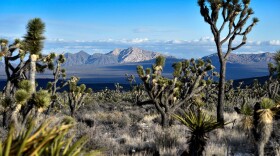Editor’s note: Heidi Kyser is on the road covering the Great Basin Water Tour, an educational tour of Nevada’s water resources June 15-18. The tour was organized by the Great Basin Water Network, the Progressive Leadership Alliance of Nevada, and Great Basin Resource Watch.
The Great Basin Water Network — a nonprofit that started in 2004 as a grassroots protest against the Southern Nevada Water Authority's plan to pipe groundwater from valleys in Eastern Nevada south to Las Vegas — is hosting a hydrological tour of the route for students, scientists, public officials, activists, and the media. (The tour also has a northern component that starts in Reno and moves east, focusing on water in mining. The two legs of the tour will meet at Baker, Nevada, outside Great Basin National Park.) It’s been about a decade since the network did such a tour, and the group figured it was time to educate newcomers to the issue and rouse stalwart supporters who may have grown complacent. The water pipeline plan has been dormant for a few years, trapped in litigation before the state Supreme Court, which kicked it back to the State Engineer's office for further review, but — as I heard repeated solemnly a few times yesterday — it’s still very much alive. Activists figure that, in a state where the proposed Yucca Mountain nuclear dump has been killed and reanimated a half-dozen times, you can never be too careful.
Whenever I mentioned the water tour to someone over the past couple weeks — my editor, the dog-sitter, yoga class substitute — they would ask for examples of what I’d be writing about. I replied with the first thing that came to mind, since it was the first stop on the tour itinerary: A visit to Coyote Springs, a planned community an hour north of Las Vegas on Highway 93 that was to have been nearly twice the size of Summerlin. And I unanimously got this sort of reply: "Whatever happened to that thing? Is it still alive? Does anyone live there?"
I didn't know the answer then, but I do now: yes, and no. Yes, there is some activity at Coyote Springs — sprinklers keeping the golf course green, electric carts motoring players around. And no, nobody lives there, and it doesn't look like anybody will anytime soon. Our tour group stood on a man-made hill above the boulders and palm trees arranged around empty basins meant to hold pools and waterfalls at the development's grand entrance off Highway 93 an hour north of Las Vegas. From our perch, we got a sweeping view of the grassy green anomaly interrupting the natural desert landscape of the north-south valley.
“This was to be the next Lake Las Vegas,” Great Basin Water Network’s Howard Watts said.
To realize that vision, land owner Harvey Whittemore needed water. The story goes that Whittemore swapped his property’s groundwater rights for SNWA’s assurance that he could access water from the pipeline that the water authority was planning to build through the valley. (SNWA could not be reached for comment by press time.) According to hydrologist Tom Myers, who is on contract with the Great Basin Water Network, Whittemore, the water authority, and Carson City-based Vidler Water Company had been granted rights to some 16,000 acre-feet of water in the area, and applications for rights to tens of thousands of acre feet more had been filed when the State Engineer halted all action in the area and called for a study to determine the proper capacity and allocation of Coyote Spring basin water.
“Pump tests determined that that level of development would negatively affect the springs," Myers says. "So, all the other applications (beyond the 16,000 acre-feet already allotted) were stopped."
Add to that obstacle the Great Recession and SNWA’s shelving of the water pipeline plan, and Whittemore's desert oasis dream was dead in the water. His own personal problems didn't help; as Coyote Springs languished, Whittemore served a prison sentence for making illegal political campaign contributions.
But Nevada is a state that rarely says never to development, and there are signs of life at Coyote Springs beyond green grass and golf carts. In 2015, a court settlement cleared the way for the new owners to start building on the site (though it doesn't appear to have happened yet). And last year, a restaurant opened in the golf club.
Is it a Summerlinesque planned community in the middle of the desert? Not exactly. But it’s still using those 16,000 acre-feet of water rights, and that's enough for opponents to keep an eye on it.
“When you pump out of basin fill, you're going to lower the water table eventually,” Myers says. "And basins like this one are interconnected with the water flowing throughout these valleys.”






